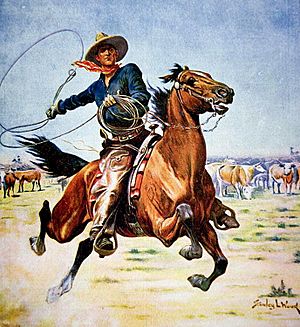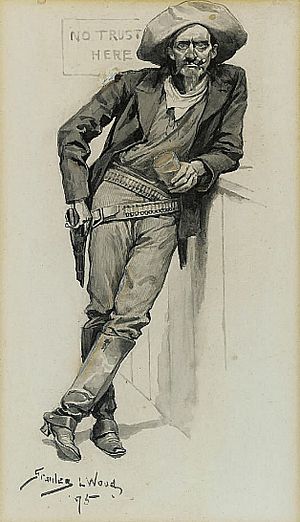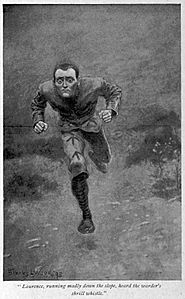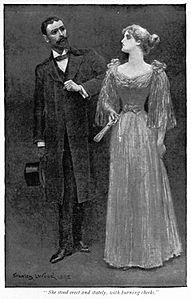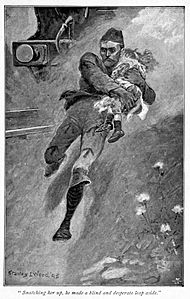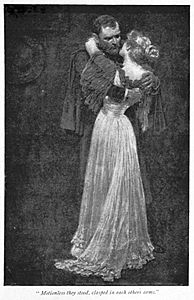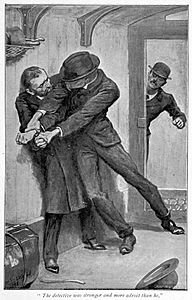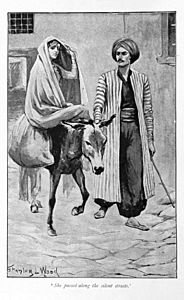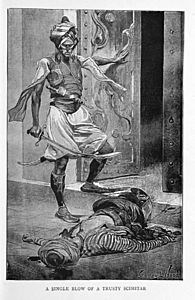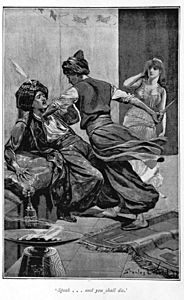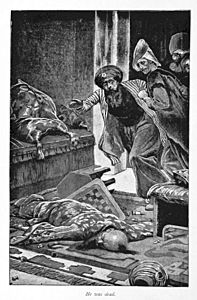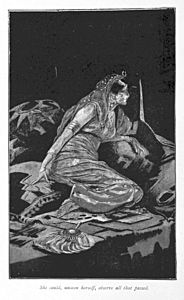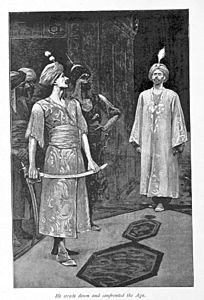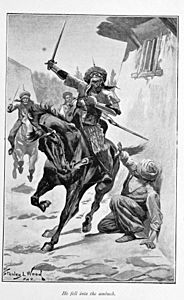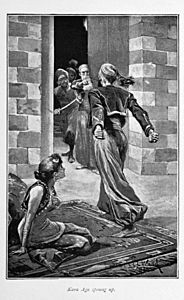Stanley L. Wood facts for kids
Quick facts for kids
Stanley Llewellyn Wood
|
|
|---|---|
| Born | 10 December 1866 Newport, Monmouthshire, Wales
|
| Died | 1 March 1928 (aged 61) Palmers Green, Enfield, London, England
|
| Nationality | Welsh |
| Other names | Stanley L. Wood |
| Occupation | Illustrator and artist |
| Years active | – |
| Known for | Dramatic drawings of horses in motion |
|
Notable work
|
Captain Kettle |
Stanley Llewellyn Wood (born December 10, 1866 – died March 1, 1928) was a talented Welsh artist. He was known for drawing exciting pictures of horses in action. He also created the black-and-white illustrations for the popular Captain Kettle adventure stories. Stanley Wood traveled a lot and his experiences helped him create amazing artwork.
Contents
Early Life and American Adventures
Stanley Wood was born in Newport, Wales, on December 10, 1866. His father, Stanley James Wood, was a businessman. When Stanley was about five or six years old, his family moved to America. They joined a new English settlement called Victoria in Kansas.
The family hoped to find a busy new town, but Victoria was very quiet. It only had one main building, which was the train station and a hotel. Many of the other settlers were young men who preferred having fun over farming. Stanley's family found the wild behavior of the young men and local cowboys difficult. They soon moved to Kansas City.
Stanley's father then got a job with the Union Pacific railway in Lawrence, Kansas. The family moved there, and the children went to school. However, their tough times continued. Stanley's father left his job to try and sell a new well-digging tool. Sadly, he became very ill while demonstrating the tool near Wichita, Kansas and passed away on May 27, 1877.
After his father's death, the family faced another scary moment. They were living in a house where the previous owners had been buried in the garden after an Indian raid. One night, a group of Native Americans surrounded their house. Stanley's mother quickly had the children put on boots and make loud noises. This made it sound like there were many cowboys inside, which scared off those outside. The family then returned to England.
Stanley had four older sisters. His second oldest sister, Jessie M., became an artist's apprentice. She later moved to New York and became a designer for a famous fashion house. Jessie eventually became a drama critic for a newspaper, illustrating her own reviews!
Becoming a Famous Illustrator
By 1891, Stanley Wood was working as an artist. It's not clear how he learned his skills, but he was very good. His artwork was accepted by the Royal Academy of Arts, a very important art institution in London. He showed several paintings there, often featuring military scenes or horses.
Stanley's first book illustrations were for The Tales of The Spanish Boccaccio in 1888. He also illustrated a large four-volume edition of The Arabian Nights Entertainments.
He worked a lot for the publisher Chatto & Windus, illustrating many adventure stories for boys. In 1888, The Illustrated London News sent Stanley to South Dakota. This trip helped him use his childhood experiences of the American Old West in his art. For many years, he drew pictures of cowboys and Native Americans. His illustrations also appeared in Harper's and Pearson's Magazine. He even illustrated early science fiction stories!
Stanley also created many illustrations about Africa. These were for books by Bertram Mitford, like The Gun Runner and The King's Assegai. In 1900, he drew 100 illustrations for an American edition of The Book of the Thousand Nights and a Night.
During the Second Boer War, his drawings of horse scenes appeared in magazines like Black & White. He also worked for War Illustrated during World War I.
Examples of Stanley Wood's Book Illustrations
Stanley Wood created eight illustrations for the book Convict 99, written by Marie Connor and Robert Leighton in 1898. This book was a powerful story about prison life. Here are some examples of his work from that book:
He also provided 28 illustrations for Romances of the Old Seraglio (1894) by H. N. Crellin. This book featured more stories set in the world of Arabian Nights. Here are some of those illustrations:
Later Life and Legacy
Stanley Wood married Mary Elizabeth Jenkins in London in 1899. He passed away at his home in Palmers Green, North London, on March 1, 1928, after being ill for some time. He was survived by his wife and three adult sons.
Many people have praised Stanley Wood's artwork. Experts say his illustrations were often wash drawings, which means they used diluted ink or paint to create different shades. This technique helped his drawings look great when printed. He was known for his strong, dramatic style and for making his American "frontier" backgrounds look very real.
One expert said that Stanley Wood's drawings "anticipated the 'headlong dash' and wild west thrillers of the modern films." Another described him as one of the "famous artists associated with the Boy's Own Paper" magazine. He is especially remembered for his exciting, action-packed drawings that truly brought stories to life for young readers.
A book dealer named Jeff Dykes once wrote, "No better horse artist ever lived than Stanley L. Wood - there was more action in a Stanley Wood illustration than in the story itself." This shows how much his dynamic horse drawings were admired.


